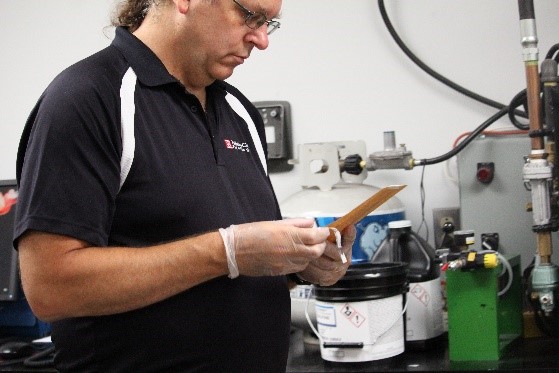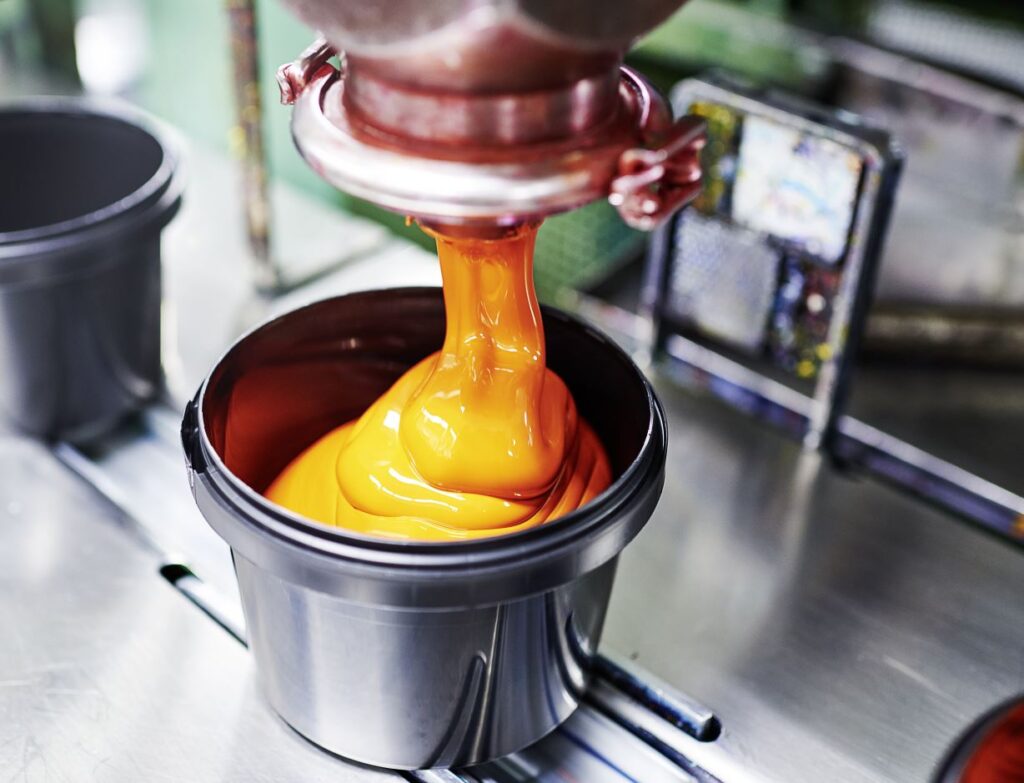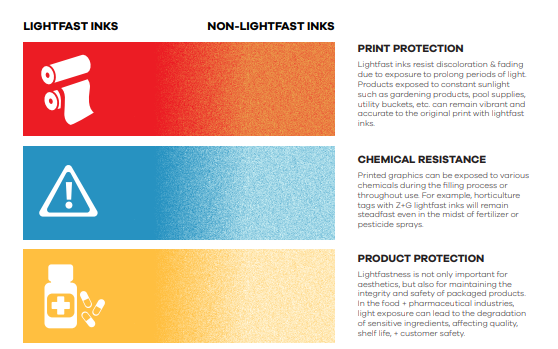Comprendre la résistance à la lumière des encres d'imprimerie
La résistance à la lumière est la capacité des encres d'imprimerie à résister à la décoloration ou à la décoloration lorsqu'elles sont exposées à la lumière artificielle ou naturelle.. C'est une caractéristique essentielle, en particulier dans les applications où le produit final sera probablement affiché, stocké, ou utilisé dans des environnements bien éclairés, tels que les étagères des magasins de détail ou les environnements extérieurs. Les encres résistantes à la lumière sont responsables du maintien de l'intégrité de l'impression, qualité, permanence de l'encre, et même la fraîcheur des produits, face à un soleil constant et/ou à une lumière artificielle.
Zeller+Gmelin est un fier fabricant d'une variété d'encres résistantes à la lumière pour offset feuilles, décalage d'âme, décalage sec et flexographie applications d'impression. Pour obtenir une résistance à la lumière acceptable, Zeller+Gmelin utilise des pigments de haute qualité, colorants, et formulations résistantes aux rayons UV et autres sources lumineuses. Vérifié par des tests approfondis, Encres résistantes à la lumière Z+G il est prouvé qu'ils résistent aux effets dégradants de l'exposition à la lumière et conservent leurs couleurs et leur aspect d'origine sur une période prolongée.
Avantages de la résistance à la lumière
En imprimerie, la résistance à la lumière est un facteur clé pour garantir que les graphiques imprimés conservent leur éclat et leur clarté au fil du temps.. Les produits et les affiches exposés à la lumière du soleil ou à des sources de lumière artificielle pendant des périodes prolongées peuvent subir une décoloration ou des changements de couleur., entraînant une perte d’attrait visuel et un dommage potentiel à l’image d’une marque. L’utilisation d’encres résistantes à la lumière présente de nombreux avantages:
Protection d'impression. Les encres résistantes à la lumière résistent à la décoloration et à la décoloration dues à une exposition prolongée à la lumière.. Cette caractéristique de l’encre est un facteur important pour maintenir l’image de marque à travers divers environnements et utilisations.. Les encres résistantes à la lumière maintiennent la permanence et la brillance de l'impression tout au long du cycle de vie du produit.. Produits exposés à la lumière constante du soleil tels que les étiquettes horticoles, fournitures de jardin et de piscine, seaux utilitaires, et signalisation extérieure peut rester dynamique et précis par rapport à l’impression originale, Lorsque vous utilisez des encres Lightfast.
Résistance chimique. Les pigments résistants à la lumière sont connus pour leur résistance à diverses formes de lumière, mais ils peuvent également être formulés pour résister à l'exposition à divers produits chimiques pendant le processus de remplissage ou tout au long de l'utilisation du produit.. Par exemple, les étiquettes horticoles résistantes à la lumière peuvent entrer en contact avec des engrais, sprays ou eau, qui nécessitent une formulation d’encre spéciale pour éviter les dommages causés par les produits chimiques ou l’humidité.
Conformité & Permanence. Certaines zones de l'emballage sont extrêmement importantes à conserver tout au long de l'utilisation du produit afin de protéger la sécurité des consommateurs.. Descriptifs de produits, instructions, les étiquettes d'avertissement et les informations de conformité sont essentielles à une utilisation appropriée du produit et à la sécurité des consommateurs.. Ces sections d'impression doivent être entretenues tout au long du cycle de vie du produit.. Des encres résistantes à la lumière peuvent être utilisées pour garantir la permanence de ces éléments de sécurité importants de votre emballage..
Emballage recyclable. Si vos contenants et emballages sont conçus pour être recyclés, les encres résistantes à la lumière sont une bonne option en raison de leur capacité à adhérer efficacement au matériau d'impression et à ne pas déteindre dans le cycle de lavage lors du recyclage.. Si les pigments venaient à se dégrader au lavage, cela pourrait nuire à la coloration des plastiques à recycler et réduire la recyclabilité du matériau.
En utilisant des encres aux excellentes propriétés de résistance à la lumière et en sélectionnant des matériaux appropriés, les imprimeurs et les fabricants peuvent garantir que leurs produits conservent leur attrait visuel, intégrité de la marque, et la qualité des produits tout au long de leur durée de vie prévue, avec la sécurité des consommateurs et les avantages respectueux de l'environnement.
Mesurer la résistance à la lumière
Lors du développement d’encres résistantes à la décoloration, nos pigments sont choisis pour répondre aux normes minimales de Blue Wool Scale (ISO 105 B02) de 5 à travers 8 lorsque la résistance à la lumière est requise dans l’application du produit final. Pour déterminer la résistance à la lumière des produits imprimés, Zeller+Gmelin effectue divers tests dans des conditions contrôlées, simulant une exposition réelle à la lumière extérieure naturelle et aux conditions météorologiques à l'aide d'un fadeomètre à arc au xénon. En effectuant des tests d'exposition contrôlée et en utilisant des techniques de mesure des couleurs, la résistance à la lumière des encres d'impression peut être évaluée et choisie avec précision pour garantir la longévité et la qualité visuelle de votre produit imprimé final.
Il est important de considérer que la mesure de la dégradation lumineuse dépend de plusieurs variables. Par exemple, l'impression exposée en juillet peut durer 20 – 25 jours, alors que le même tirage exposé en novembre pourrait théoriquement durer jusqu'à 140 jours.
Bien que les technologies de séchage LED et UV sèchent efficacement l'encre, vous souhaiterez peut-être soustraire des jours supplémentaires pour les différences de latitude, altitude, emplacement, exposition à la pollution de l’air et à d’autres produits chimiques, humidité, et les effets des intempéries. L'essentiel est que, tandis que la Blue Wool Scale est utile pour choisir la bonne pigmentation pour votre produit., le client doit en fin de compte surveiller et tester ses propres résultats dans ses conditions d'application et de terrain uniques.
Considérations importantes concernant les encres d'impression résistantes à la lumière
Il y a plusieurs facteurs importants à prendre en compte lors du choix des encres résistantes à la lumière et du classement Blue Wool Scale nécessaire pour votre application.. Voici quelques bonnes pratiques d'impression et informations « à connaître » fournies par les spécialistes des encres de Zeller+Gmelin.:
Les encres résistantes à la lumière sont disponibles dans un nombre limité de pigments et ne sont pas disponibles pour les couleurs fluorescentes vives ou pastel.. Ces encres ont tendance à utiliser des pigments plus foncés et « plus sales » pour résister aux éléments et à l'exposition à la lumière pendant de longues périodes. Il est donc important de s'assurer que le design d'impression peut être réalisé avec ces pigments spécialisés..
Tous les revêtements ne sont pas compatibles avec les encres résistantes à la lumière et peuvent réduire l'efficacité de leurs propriétés de résistance à la décoloration. Vérifiez auprès de Zeller+Gmelin pour vous assurer que votre revêtement maintient efficacement sa résistance à la lumière dans les différents environnements de terrain requis..
Si votre produit est destiné à être utilisé pendant une période prolongée, il est préférable d'utiliser des encres résistantes à la lumière pour conserver l'impression de l'emballage tout au long de l'utilisation complète du produit. – ou du moins dans les sections instructions et conformité. Cela peut garantir que les couleurs de votre marque restent fidèles et que les informations importantes ne s'estompent pas avec le temps..
Résistantes à la lumière et « résistantes aux intempéries » sont deux caractéristiques différentes des encres. Si votre produit est utilisé et stocké à l'extérieur, l'encre doit être à la fois résistante à la lumière et aux intempéries. Alors que, si votre produit est utilisé uniquement à l'intérieur, alors une encre résistante à la lumière suffira. Les encres résistantes aux intempéries sont toujours résistantes à la lumière, bien que les encres résistantes à la lumière ne soient pas toujours résistantes aux intempéries.
Rappelez-vous que le la résistance à la lumière des pigments varie en fonction de l'application et de l'exposition de votre produit final. Assurez-vous de tester l'impression dans vos conditions uniques pour vous assurer qu'elle résistera aux éléments dégradants trouvés dans l'environnement souhaité..
Les spécialistes des encres Zeller+Gmelin connaissent les encres résistantes à la lumière et aux intempéries et peuvent vous aider à choisir la meilleure solution couleur pour votre application d'impression.. Contactez notre équipe pour en savoir plus sur cette caractéristique importante de l'encre et découvrir la meilleure note recommandée pour atteindre vos objectifs d'impression et de marque..
Avantages des encres résistantes à la lumière
La résistance à la lumière est la capacité des encres d'imprimerie à résister à la décoloration ou à la décoloration lorsqu'elles sont exposées à la lumière artificielle ou naturelle.. C'est une caractéristique essentielle, en particulier dans les applications où le produit final sera probablement affiché, stocké ou utilisé dans des environnements bien éclairés, tels que les étagères des magasins de détail ou les environnements extérieurs. LIRE LA SUITE




